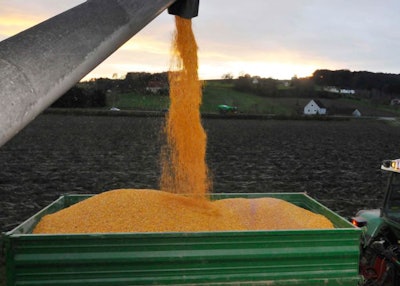
Economists say corn prices are poised to take a tumble in 2023; soybean prices less certain
The coming year may finally give feed producers a break from soaring corn prices.
Prices for corn and soybeans ticked slightly upward last week after the U.S. Department of Agriculture (USDA) released a report making further cuts to the estimated size of the 2022 harvest. But while global markets seem focused on the size of the U.S. crop, economists and traders are paying attention to what is shaping up to be a significant loss of global demand for corn.
The USDA cut expected exports of the 2022 crop from the U.S. by 150 million bushels in its January World Agricultural Supply and Demand Estimates, after several months of declining exports. The USDA’s corn export forecast is now the second lowest issued in the past six years, according to James Mintert, director of the Center for Commercial Agriculture at Purdue University. Incomplete sales are falling to even lower levels, he said in a January 13 podcast, which could bring the USDA’s estimates even lower.
Although December 2023 corn futures were selling for US$5.98 per bushel as of Friday morning, Mintert said he believes there is a good chance corn could fall below US$5 before then.
Soybean prices are a different story. Although December 2023 futures for soybeans sat at US$13.91 per bushel on Friday morning, Nathan Thompson, a professor of agricultural economics at Purdue University, said soybeans could realize a wide range of potential prices in the coming year. He said there were equal chances of soybean prices falling below US$12.40 per bushel or rising as high as US$15.33.
The different projections for the two key crops led Emily French, founder of the Global Ag Protein brokerage, to question the logic of USDA’s projections. Speaking to the U.S. Soybean Export Council on January 12, she said she found it improbable that demand for corn and other commodities like wheat would fall so dramatically in the coming year while soybeans remain unscathed.
“If someone has an answer [for how this could happen] I would love to hear it,” French said. “Am I the only person who looks at this and it just doesn’t add up?”
Mintert, however, saw a possible explanation. The difference, he said, seems to be tied to demand for soybean oil, driven by an expansion of biofuel production that is expected in response to U.S. climate policy. It remains to be seen whether the expansion will unfold as envisioned, but if it does, it could usher in a new paradigm for U.S. agriculture.
“We could see a scenario that … winds up pushing much more of a soybean environment,” he said. “A continuous soybean environment or at least multiyear soybeans.”








